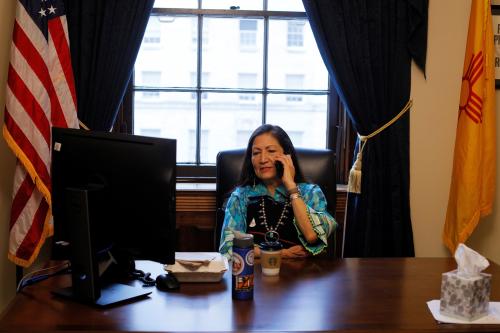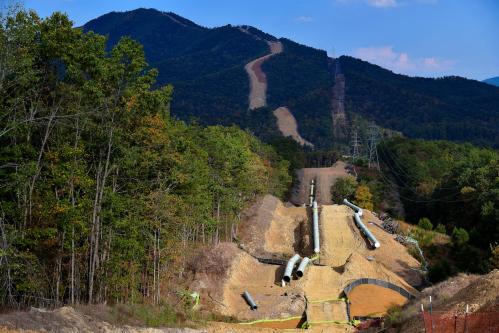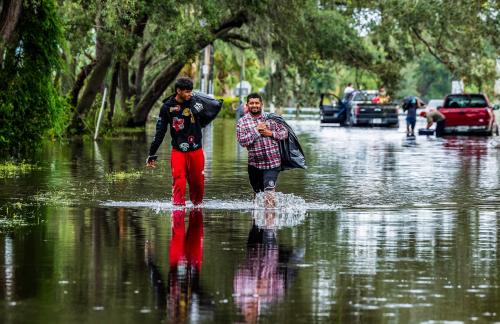The pandemic—and more recently, the Texas power crisis—have brought attention to infrastructure challenges that have long plagued American Indian tribes and their citizens. Over the past 150 years, the Navajo Nation has been a site of resource extraction, but has not received the infrastructure necessary to use those resources to the benefit of the Navajo people. To this day, many Navajo citizens live without electricity.
The Navajo Nation possesses the necessary expertise and experience to electrify all homes on its reservation, but it needs help to do so. Created in 1959, the Navajo Tribal Utility Authority (NTUA) is a tribally owned non-profit. The average cost for NTUA to connect a home to an existing electric distribution line is $40,000. While other homes across the U.S. gained electricity in the early 1930s, the first large scale effort to do so on Navajo Nation was not until 1980 when NTUA received financial assistance to do so, through its first loan from the USDA Rural Utility Service. While loans are certainly better than no funding at all, treaty and trust responsibilities create a federal obligation to support electrification in Indian country by providing grant funding. The federal government established the Navajo reservation as a “permanent homeland” for the Navajo people. Electricity is essential to modern life and a standard of living off-reservation. In the 21st century, electricity is a necessary condition for any lands to be a permanent homeland.
Understanding why Navajo Nation does not possess adequate electricity requires an understanding of the history of energy development on the Nation. Mining of coal and uranium on the Nation was initially pushed by the United States under the guise of “modernization.” The federal government believed that the Nation needed to transition to a capitalist, industrial economy through resource development. The Nation possessed a highly valuable collection of fossil fuels. Several private sector coal companies sought to mine coal on lands shared by the Navajo and Hopi, while at the same time, the U.S. federal government coveted the Nation’s rich stores of uranium.
The top-down, industrial approach to mineral extraction on the Navajo Nation had severe environmental and health consequences. The royalties went to the Navajo General fund, but the Nation was paid far below the market rate for its coal. This legacy of extraction also threatened the ability of the Navajo people to maintain traditional ways of life while exporting energy away from the reservation. As a result, Navajo Nation was left with all the negative harms of energy extrapolation with little, if any, of the benefits.
While the Department of Interior signed leases on behalf of the Nation allowing Peabody Energy and other companies to extract these resources, the federal government simultaneously failed to build much needed infrastructure. In 1966, under pressure from energy lobbyists, Congress enacted a developmental ban on land near the Black Mesa Mine, commonly known as the “Bennett Freeze.” The Freeze wasn’t completely lifted until 2009. Accordingly, for over forty years, the extension of electricity was legally prohibited on over 1.5 million acres of Navajo land.
At present, a dizzying array of cooperatives provide power to the Navajo Nation, each of whom have their own service territory, making it difficult to coordinate between cooperatives. Despite being surrounded by power plants that electrify Phoenix, Los Angeles, Albuquerque and other distant cities, almost 30 percent of homes do not have electricity on the Navajo reservation. And so, when the pandemic struck, many Navajo families were left to fight a battle against disease and bone chilling cold in the dark.
For the past year, the pandemic has ravaged the Navajo Nation, which has experienced more COVID-19 cases than any other tribe in the United States. With a mortality rate of approximately 8 per 1,000 (1,358 deaths out of a population of 173,000), the Nation has lost almost 1% of its population in one year and faces an existential threat to the survival of traditional knowledge due to the loss of its elders, who are the gatekeepers of cultural history and traditional teachings.
While the rest of America logged onto their Wi-Fi to work remotely and ordered groceries online for no-contact delivery, many within the Navajo Nation were unable to take basic precautions against COVID-19, forced to haul water over a mile, and heat their homes with lumps of coal burned in wood stoves.
Electrification brings heat, light, better medical care, and improved education. To save future lives, Navajo Nation must be electrified. The Biden Administration’s recent actions are a step in the right direction. First, the Administration has announced its commitment to fulfilling federal treaty and trust responsibilities to tribes. In line with this commitment, when the Administration announced its intent to rebuild America’s infrastructure, Tribal communities were included.
The federal government should fulfill its treaty and trust responsibilities by providing grant funding to empower Tribal governments to take action, but leave the actual decision making to the tribes who know their land and people best. Specifically, working with local cooperatives, the NTUA is electrifying over 500 homes with CARE funds approved under the Trump Administration. The Biden Administration should specifically earmark money for electrifying all remaining Navajo households. In addition, the federal government could expand Job Corps or AmeriCorps to provide training and education for Navajo youth so that they can become the next cadre of solar engineers. Notably, once all Navajo homes are fully electrified, the work is not complete. The current grid is old and outdated, and requires significant improvements, upgrades and modernization—particularly to accept the variable energy produced by solar and wind power. One piece of low hanging fruit would be for the Biden Administration to train Navajo and other Native American engineers to begin the process of transforming the current coal based electrical grid in the Four Corners area. These engineers can work with the Nation to ready the grid to receive more solar and wind energy.
From a regulatory standpoint, the challenge for electrification, grid expansion and connection solutions for Navajo Nation is to ensure that energy projects reflect the will of the Navajo people, while meeting goals for economic development, cultural preservation, environmental protection, and sovereignty. Such investment will create jobs for the Navajo people on their ancestral lands, while providing them a safe and sustainable form of energy.
Heather Tanana is a citizen of the Navajo Nation and Assistant Research Professor & Stegner Center Fellow at the S.J. Quinney of Law – University of Utah;
Warigia Bowman is an Associate Professor of Law and Director of the Sustainable Energy and Resources Law Program at the University of Tulsa College of Law
The Brookings Institution is committed to quality, independence, and impact.
We are supported by a diverse array of funders. In line with our values and policies, each Brookings publication represents the sole views of its author(s).








Commentary
Energizing Navajo Nation: How electrification can secure a sustainable future for Indian Country
July 14, 2021